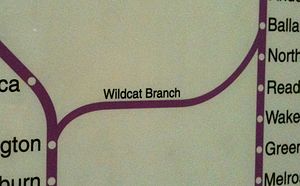Wilmington – Wilmington Junction railway line
| Wilmington MA-Wilmington Junction MA | |||||||||||||||||||||||||||||||||||||||||||||||||||||
|---|---|---|---|---|---|---|---|---|---|---|---|---|---|---|---|---|---|---|---|---|---|---|---|---|---|---|---|---|---|---|---|---|---|---|---|---|---|---|---|---|---|---|---|---|---|---|---|---|---|---|---|---|---|
|
The route on an MBTA network map.
| |||||||||||||||||||||||||||||||||||||||||||||||||||||
| Route length: | 5.26 km | ||||||||||||||||||||||||||||||||||||||||||||||||||||
| Gauge : | 1435 mm ( standard gauge ) | ||||||||||||||||||||||||||||||||||||||||||||||||||||
| Society: | MBTA | ||||||||||||||||||||||||||||||||||||||||||||||||||||
| Shared use: | Amtrak , PAR | ||||||||||||||||||||||||||||||||||||||||||||||||||||
|
|||||||||||||||||||||||||||||||||||||||||||||||||||||
The railway line Wilmington - Wilmington Junction (also Wildcat Branch ) is a railway line in the urban area of Wilmington in Massachusetts ( United States ). It is 5.26 kilometers long and connects the Boston-Lowell railway line and the lines crossing in Wilmington Junction. The single-track, standard-gauge line belongs to the Massachusetts Bay Transportation Authority (MBTA), which runs several suburban trains on the Boston – Haverhill route over it during rush hour. Amtrak's " Downeaster " express trains also operate the route from Boston to Portland. Pan Am Railways operate the freight transport .
history
As early as 1836 to 1848 there was a railway line from Wilmington to Wilmington Junction. It was built by the Andover and Wilmington Railroad , which later became part of the Boston and Maine Railroad . The Boston & Maine had to use the main line of the Boston and Lowell Railroad for their trains to Boston , which regularly led to traffic delays. They therefore built their own main line via Reading to Boston in 1845, which branched off from the previous line in Wilmington Junction. The original route to Wilmington was therefore closed.
In 1858, Boston & Lowell took over management of the Peabody – Tewksbury Junction railway line , which crossed the Boston & Maine mainline in Wilmington Junction. In order to create a cross connection from its own main line to this railway, it built a new railway line in 1874, which did not use the route of the disused railway, but a route further east. It went into operation on December 2, 1874. The line was primarily used for freight traffic, but some passenger trains from Boston to Lawrence were also run over it.
From 1887 on, Boston & Maine was in charge of operations after leasing Boston & Lowell. In August 1924, the last passenger train that had been running on the line was stopped. It was not until 1959 that passenger trains ran regularly over the Wildcat Branch. As before 1845, Boston & Maine ran its suburban trains to Haverhill and the express trains to Maine via Wilmington. A new stop was set up on Salem Street, but only a few trains served it.
In 1976 the MBTA took over the route and the suburban trains from Boston to Haverhill. Express trains to Maine hadn't run since 1965. As early as 1979 she stopped the passenger traffic on the line and ran her Haverhill trains again via Reading. A few years later, individual train runs on this route were again routed via Wilmington in rush hour traffic to avoid overloading the partially single-track route via Reading. Guilford Transportation took over freight transport in 1983 and has operated under the name Pan Am Railways since 2006 . Since 2001 Amtrak has been operating the "Downeaster", an express train from Boston to Portland. These trains also run through Wilmington so as not to obstruct suburban traffic on the Reading route.
Route description
The line begins right at Wilmington Station and turns north off the Boston – Lowell railway line . It first crosses Main Street, where an overland tram passed from Boston to Lowell in the early 20th century. The railway line crosses the urban area of Wilmington almost in a straight line. The former station of the same name is located in front of the Salem Street level crossing. The platform is still there. In the further course, the route crosses a forest and reaches the junction of Wilmington Junction, where it joins the main route of the former Boston & Maine.
passenger traffic
With the opening of the line, Boston & Lowell introduced a new train route that ran from Boston via Wilmington, Wilmington Junction and Salem Junction to Lawrence. In 1881 ten trains ran on this route. Even after the takeover by Boston & Maine, this train route was retained, but it stopped Sunday traffic. After several interurban trams had been opened in the region, more and more trains were cut on the route, so that in 1901 only four and in 1916 only one pair of trains ran. In August 1924, the last pair of trains on the Wildcat Branch was canceled.
After passenger traffic on the route was resumed in 1959, six express trains drove on weekdays to Maine and 16 suburban trains to Haverhill. Five express trains and seven suburban trains ran on Sundays. The Salem Street stop was only served during rush hour traffic in the direction of thrust, i.e. early in the direction of Boston and in the afternoon from the direction of Boston. In 2010, five MBTA trains run Monday through Friday in the direction of Boston via the Wildcat Branch. There is only one train going to Haverhill.
literature
- Ronald D. Karr: The Rail Lines of Southern New England. A Handbook of Railroad History. Branch Line Press, Pepperell, MA 1995. ISBN 0-942147-02-2
- Mike Walker: Comprehensive Railroad Atlas of North America. New England & Maritime Canada. (2nd edition) SPV-Verlag, Dunkirk (GB), 2010. ISBN 1-874745-12-9
Web links
- B&M Corporate History, 1914, pages 87-88 (PDF; 6.9 MB) ( Memento from June 17, 2009 in the Internet Archive ) (English)
Individual evidence
- ↑ see timetables of the route from the years mentioned.
- ↑ current timetable of the MBTA ( Memento from June 17, 2012 in the Internet Archive ) (PDF; 183 kB)
